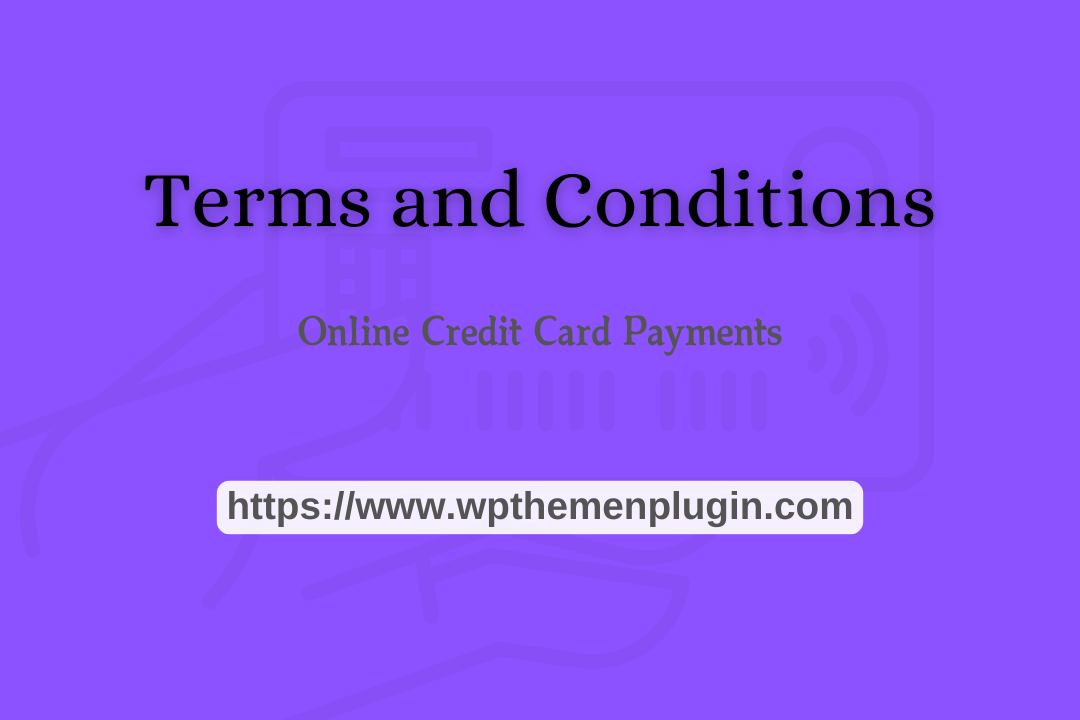
Terms and Conditions for Credit Card Use on Ecommerce Website
in WordPress Knowledge on August 31, 2024Understanding the Terms and Conditions for Credit Card Use on ECommerce Website
In the rapidly evolving landscape of e-commerce, ensuring the security and smoothness of transactions is paramount for both merchants and consumers. One of the key elements in achieving this is establishing clear and comprehensive terms and conditions book for credit card use on e-commerce websites. This article provides a detailed overview of what these terms and conditions typically include, why they are important, and how they protect both parties involved.
Introduction
E-commerce has revolutionized the way we shop, offering convenience and accessibility that traditional brick-and-mortar stores cannot match. However, with this convenience comes the responsibility of safeguarding sensitive financial information. Credit card transactions are at the heart of most e-commerce transactions, making it essential to have well-defined terms and conditions. These terms outline the rules and expectations for both the merchant and the consumer, ensuring a smooth and secure transaction process.
Key Components of Credit Card Terms and Conditions
**1. Acceptance of Terms
- Description: Consumers must agree to the terms and conditions before completing a transaction. This agreement often takes place when users check a box or click a button acknowledging that they have read and accept the terms.
- Importance: Ensures that consumers are aware of and agree to the rules governing their use of credit cards on the site.
**2. Payment Information
- Description: Details what payment methods are accepted (e.g., Visa, MasterCard, American Express), how payment information should be entered, and the handling of billing details.
- Importance: Clarifies which credit cards are accepted and how users should securely provide their payment information.
**3. Security Measures
- Description: Outlines the security protocols in place to protect users’ credit card information, such as encryption, tokenization, and secure payment gateways.
- Importance: Reassures consumers that their payment information is secure and protected from unauthorized access.
**4. Transaction Authorization
- Description: Explains the process for authorizing transactions, including any steps consumers must take to verify their identity or confirm their purchase.
- Importance: Ensures that transactions are legitimate and authorized, reducing the risk of fraud.
**5. Billing and Charges
- Description: Details how charges will appear on credit card statements, including any potential additional fees (e.g., handling fees, international transaction fees).
- Importance: Provides transparency about the costs associated with purchases and how they will be reflected on credit card statements.
**6. Refunds and Cancellations
- Description: Outlines the procedures for requesting refunds or canceling transactions, including any applicable terms, conditions, or time frames.
- Importance: Sets clear expectations for consumers regarding how they can resolve issues with their purchases.
**7. Dispute Resolution
- Description: Provides a process for resolving disputes related to credit card transactions, including who to contact and how disputes will be handled.
- Importance: Offers a structured approach for addressing and resolving issues that may arise during or after a transaction.
**8. Data Privacy
- Description: Describes how consumers’ personal and payment information will be collected, used, and protected in accordance with privacy laws and regulations.
- Importance: Ensures compliance with data protection laws and reassures consumers that their information will be handled responsibly.
**9. Liability for Unauthorized Transactions
- Description: Specifies the liability of both the consumer and the merchant in the event of unauthorized or fraudulent transactions.
- Importance: Clarifies responsibility for any financial loss resulting from unauthorized use of credit card information.
**10. Amendments to Terms
- Description: States how and when the terms and conditions may be updated or amended, and how consumers will be notified of these changes.
- Importance: Keeps consumers informed about any changes to the terms that might affect their transactions.
Terms and Conditions Numbered List
1. Acceptance of Terms
- Process: Consumers must read and agree to the terms and conditions before completing a purchase. This is typically done through a mandatory checkbox or a digital signature.
- Implications: This agreement creates a legal contract between the consumer and the merchant, outlining both parties’ rights and obligations.
2. Payment Information
- Process: Consumers enter their credit card details on a secure payment page. Merchants must ensure that this page is encrypted to protect sensitive information.
- Implications: Accurate and secure handling of payment information is crucial for preventing fraud and ensuring successful transactions.
3. Security Measures
- Protocols: Common security measures include SSL/TLS encryption, PCI-DSS compliance, and tokenization.
- Implications: These measures protect against data breaches and ensure that payment information is securely transmitted and stored.
4. Transaction Authorization
- Process: Consumers may need to provide additional verification, such as a one-time password (OTP) or biometric authentication, to complete a transaction.
- Implications: Enhances the security of transactions and helps prevent unauthorized purchases.
5. Billing and Charges
- Process: Charges are processed and reflected on the consumer’s credit card statement. Any additional fees should be disclosed at the time of purchase.
- Implications: Transparency about billing ensures that consumers are aware of all costs associated with their purchase.
6. Refunds and Cancellations
- Process: Consumers request refunds or cancellations according to the merchant’s policies, which may include providing a reason for the request and adhering to specific time frames.
- Implications: Clear policies help manage consumer expectations and streamline the resolution process for returns and refunds.
7. Dispute Resolution
- Process: Consumers can contact customer service to address issues or disputes related to transactions. Merchants should provide clear instructions on how to initiate a dispute.
- Implications: A well-defined dispute resolution process helps resolve conflicts efficiently and fairly.
8. Data Privacy
- Process: Merchants must comply with data protection regulations, such as GDPR or CCPA, and inform consumers about how their data will be used and protected.
- Implications: Protecting consumer data is not only a legal requirement but also essential for maintaining trust and credibility.
9. Liability for Unauthorized Transactions
- Process: Terms should outline the procedures for reporting unauthorized transactions and the process for resolving such issues.
- Implications: Clearly defined liability helps protect both consumers and merchants from financial losses related to fraud.
10. Amendments to Terms and Conditions Numbered List
- Process: Merchants should notify consumers of any changes to the terms and conditions, typically through email or on the website.
- Implications: Keeping terms updated and informing consumers of changes ensures that both parties are aware of their rights and responsibilities.
Conclusion
Establishing and communicating clear terms and conditions for credit card use on e-commerce websites is essential for protecting both consumers and merchants. These terms not only provide a framework for secure and transparent transactions but also help in managing expectations and resolving issues that may arise. By addressing key components such as payment information, security measures, and dispute resolution, e-commerce businesses can foster trust and ensure a positive shopping experience for their customers.
Implementing robust terms and conditions book is not just a legal obligation but a critical aspect of maintaining a secure and user-friendly online shopping environment. As e-commerce continues to grow, so too should the commitment to ensuring that credit card transactions are handled with the utmost care and integrity.
Categories: WordPress Knowledge

